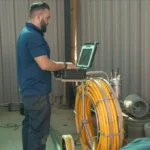
Vertical Stacks – Don’t Miss This $3Billion Market!
Raising the Bar
Advancements in CIPP materials and methods continue to push boundaries once thought impossible, especially for small diameter pipe applications. This progress, combined with an increased commitment from dedicated installers, has helped the industry reach new elevations both in structures and revenue streams. Nowhere is that growth more evident than in continuous inversion lining of vertical stacks.
For years, the focus of most small diameter lining contractors in the United States was limited to underground lateral lines from a building to the city main. But over the last two decades, some of that focus shifted to lining the sanitary drainage lines under buildings. With underground lining proving effective and cost-saving to the property owner as well as highly profitable to the industry, it is natural that the newest developments concentrate on vertical stacks, a largely untouched potential income stream in what is projected to become a $3 billion-a-year industry.
European CIPP Technology
Raymond Gray, the owner of Los Angeles-based A-1 Total Service Plumbing, is among the growing number of contractors who have recently added vertical stack lining to their services.
“We’ve been lining pipe since 2002,” said Gray, “but about three years ago, everything changed.”
Gray is referencing his 2016 trip to the IFAT Trade Show in Munich. He witnessed the potential of vertical lining in Germany, brought back those proven methods, and implemented them in his already successful underground lining business.
“And now,” he says, “we have more lining work than we know what to do with.”
Profits are Soaring
Pipelining Technologies, Inc. in South Florida has turned vertical stack lining into the lion’s share of their CIPP revenue; but that was not always the case. In 2012, when they lined their first stacks on high-rise condominiums, it was a small portion of their overall business.
“When we first started, verticals were probably five percent of our overall revenue,” recalls Senior Estimator William Pedersen. “Now that number has jumped to fifty percent of our business model.”
Pedersen cites the convenience of lining from the roof versus the conventional plumbing method of trenching, pipe removal, and replacement as the biggest reason for their success in selling this rehabilitation method. The fact that residents can remain in their homes, appeals especially to multi-level, multi-unit buildings. The ability to completely rehab a vertical stack without entering every unit drastically limits the disruption to residents’ everyday lives. This alone is a big reason that more and more property owners are choosing CIPP over total pipe replacement.
In the last five years, Pipelining Technologies has lined over 10 miles of vertical stacks in the South Florida market, generating more than $10 million in revenue solely from verticals lines. Pedersen, who was instrumental in building the marketplace for vertical lining in the South Florida high-rise community, thinks that those numbers are just scratching the surface.
“A rough guess of the plumbing infrastructure in need of pipe lining in our area? Hundreds of millions of dollars, if not more.”




